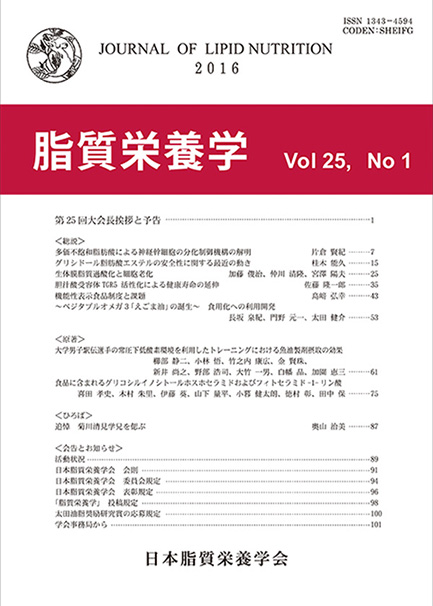All issues

Volume 25 (2016)
- Issue 2 Pages 177-
- Issue 1 Pages 7-
Volume 25, Issue 2
Displaying 1-2 of 2 articles from this issue
- |<
- <
- 1
- >
- >|
Review
-
Ruwani N Nugara, Masashi Inafuku, Hirosuke OkuArticle type: Review
2016Volume 25Issue 2 Pages 177-196
Published: 2016
Released on J-STAGE: October 20, 2016
JOURNAL FREE ACCESSLifestyle modification is the main treatment for obesity. An understanding of the mechanisms of appetite control, nutrient metabolism, and energy expenditure has greatly enhanced drug development for disorders, such as diabetes, cancer, obesity, and inflammation. Peucedanum japonicum Thunb (PJT), also known as "Chomeiso" (長命草), is a traditional herb that has been used to provide nutrition; the herb has a broad spectrum of physiological and biological properties. In our previous studies, we found that PJT has antiobesity effects, more specifically, the ethanol extract of PJT reduces obesity and diabetes symptoms in high-fat diet-fed mice. Furthermore, in one of our recent studies, we isolated the active component of PJT with antiobesity properties called pteryxin, a previously known coumarin. However, its biological properties against obesity were unknown. We determined that pteryxin played a role in adipogenesis suppression mechanisms, both in vitro and in vivo. This study details the current understanding of antiobesity effects of PJT extracts, its active compound pteryxin, and the distinctive properties of pteryxin compared with those of other natural compounds against obesity. This review will help in understanding the molecular mechanisms underlying pteryxin's effects for development of pharmaceutical drugs and nutritional products.View full abstractDownload PDF (1767K) -
Hidehiko Hibino2016Volume 25Issue 2 Pages 197-213
Published: 2016
Released on J-STAGE: October 20, 2016
JOURNAL FREE ACCESSDHA levels are not homogeneously distributed throughout an animal. There are two distinct categories, select tissues containing large amounts of DHA and the remaining tissues with normally less than a few mol%. High-DHA tissues, the rod outer segment, sperm, and brain have a large quantity of DHA. DHA is mainly found on in the sn-2 position of phospholipids. DHA is n-3 fatty acid that is essential for normal brain development and cognitive function. It was confirmed a member of the major facilitator superfamily: Mfsd2a as the major transporter for DHA uptake into brain. Mfsd2a is found to be expressed exclusively in endothelium of the blood-brain barrier of micro-vessels. Mfsd2a-KO mice show markedly reduced levels of DHA in brain accompanied by neuronal cell loss in hippocampus and cerebellum. Mfsd2a transports DHA in the form of sn-2 lysophosphatidylcholine, but not unesterified fatty acid, in a sodium ion-system. A remarkable property of MFSD2 is its high-level expression specifically in the placenta, with expression in all other tissues at least 10-fold low―with the expression of the testis in which it is only 4-fold lower than the placenta. DHA is specifically bound to fatty acid binding proteins (Fabp7) in the cytoplasm, and transported to the cell membrane and work as ligands for nuclear receptor transcription factor.View full abstractDownload PDF (2615K)
- |<
- <
- 1
- >
- >|